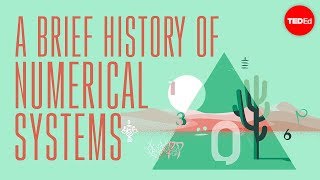(单词翻译:单击)
One, two, three, four, five, six, seven, eight, nine, and zero.
1,2,3,4,5,6,7,8,9,0。
With just these ten symbols, we can write any rational number imaginable.
只用这十个符号,我们可以写出任何有理数。
But why these particular symbols? Why ten of them?
但是为什么是这几个符号呢?为什么有十个?
And why do we arrange them the way we do?
而为什么人们会按照这样的方式排列它们呢?
Numbers have been a fact of life throughout recorded history.
有史以来,数字一直是生活中必不可少的。
Early humans likely counted animals in a flock or members in a tribe using body parts or tally marks.
最早,人们通常用身体的某部分或计数标记来表示一群动物或部落的人的数量。
But as the complexity of life increased, along with the number of things to count, these methods were no longer sufficient.
但是随着生活越来越复杂,需要数的数量也不断增加,这些方法不再够用了。
So as they developed, different civilizations came up with ways of recording higher numbers.
随着不同文明的发展,人们想出了很多用来记录更多数量的办法。
Many of these systems, like Greek, Hebrew, and Egyptian numerals,
很多数字系统,比如希腊数字,希伯来数字以及埃及数字,
were just extensions of tally marks with new symbols added to represent larger magnitudes of value.
只是原来计数标记的加强版,加入了用来代表更高数量级的新符号。
Each symbol was repeated as many times as necessary and all were added together.
每个符号都尽可能多次重复使用,再把它们加起来。
Roman numerals added another twist.
罗马数字添加了另一种方式。
If a numeral appeared before one with a higher value, it would be subtracted rather than added.
如果前面有一个值更大的数字,它们会被相减,而不会被相加。
But even with this innovation, it was still a cumbersome method for writing large numbers.
但尽管有了这种创新,对较大的数字来说,这依旧是种累赘的方法。
The way to a more useful and elegant system lay in something called positional notation.
有一种更有用、更优雅的方式,称为定位数系。
Previous number systems needed to draw many symbols repeatedly and invent a new symbol for each larger magnitude.
之前的数字系统需要不断重复地画很多符号,而且每一个更大的数量级都需要引入新的符号。
But a positional system could reuse the same symbols, assigning them different values based on their position in the sequence.
但是定位数系可以重复使用同样的符号,根据它们的位置赋予它们不同的值。
Several civilizations developed positional notation independently, including the Babylonians, the Ancient Chinese, and the Aztecs.
一些社会文明发展了自己的定位数系,其中包括巴比伦人,古中国人,还有阿芝特克人。
By the 8th century, Indian mathematicians had perfected such a system
到了第八世纪,印度数学家完善了一种记数制,
and over the next several centuries, Arab merchants, scholars, and conquerors began to spread it into Europe.
它在接下来的几个世纪中被阿拉伯商人,学者和征服者传到了欧洲。
This was a decimal, or base ten, system, which could represent any number using only ten unique glyphs.
这就是十进制,一种可以只用十个独特的图像字符就能表示出任何数字的方法。
The positions of these symbols indicate different powers of ten, starting on the right and increasing as we move left.
这些字符的位置表明了10的不同次方,从右开始,次方数向左不断递增。
For example, the number 316 reads as 6x10^0 plus 1x10^1 plus 3x10^2.
比如数字316,读成6乘以10的0次方加上1乘以10的1次方加上3乘以10的2次方。

A key breakthrough of this system, which was also independently developed by the Mayans, was the number zero.
这个方法的一个巨大突破是同时也被玛雅人发明了的数字0。
Older positional notation systems that lacked this symbol would leave a blank in its place,
旧的定位数系没有这个符号,便会在那个位置留一个空格,
making it hard to distinguish between 63 and 603, or 12 and 120.
这让63和603,12和120难以区分。
The understanding of zero as both a value and a placeholder made for reliable and consistent notation.
0,这既是一个值,又是一个占位符的特质,让它成为一个可靠、一致的符号。
Of course, it's possible to use any ten symbols to represent the numerals zero through nine.
当然,也可以用任何十个符号来代替数字0到9。
For a long time, the glyphs varied regionally.
很长一段时间,图像字符在各地区不断变化发展着。
Most scholars agree that our current digits evolved from those used in the North African Maghreb region of the Arab Empire.
大多数学者认为,我们如今的数字是从北非阿拉伯王国马格里布地区曾用过的符号进化而来的。
And by the 15th century, what we now know as the Hindu-Arabic numeral system had replaced Roman numerals in everyday life
到十五世纪,我们现在日常所熟悉的阿拉伯数字体系已经取代了罗马数字,
to become the most commonly used number system in the world.
变成了世界上最常用的数字系统。
So why did the Hindu-Arabic system, along with so many others, use base ten? The most likely answer is the simplest.
那为什么阿拉伯数字系统和其他的一些都用十进制呢?最可能的答案是因为它是最简单的。
That also explains why the Aztecs used a base 20, or vigesimal system.
这也解释了阿芝特克人使用二十进制的原因。
But other bases are possible, too.
但是其他进制也是可以用的。
Babylonian numerals were sexigesimal, or base 60.
巴比伦数字是六十进制。
Any many people think that a base 12, or duodecimal system, would be a good idea.
很多人认为十二进制也挺好的。
Like 60, 12 is a highly composite number that can be divided by two, three, four, and six,
12和60都是因数很多的合数,它们可以被2,被3,被4,被6整除,
making it much better for representing common fractions.
用这些数来表示共同因数更好一些。
In fact, both systems appear in our everyday lives,
事实上,我们日常生活中存在很多数字系统,
from how we measure degrees and time, to common measurements, like a dozen or a gross.
从测量角度和时间,到日常的计量单位,比如一打。
And, of course, the base two, or binary system, is used in all of our digital devices,
当然,二进制也被使用于所有的电子设备,
though programmers also use base eight and base 16 for more compact notation.
尽管程序员也将八进制和十六进制用于更精简的表达。
So the next time you use a large number, think of the massive quantity captured in just these few symbols,
所以下一次你使用一个很大的数字时,想想你仅用了这几个符号就获得了一个如此大的量,
and see if you can come up with a different way to represent it.
也试试看你是否能用不同的方式把它表达出来。


